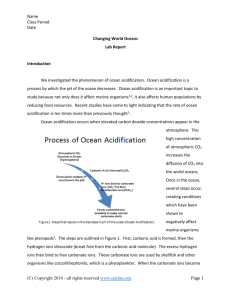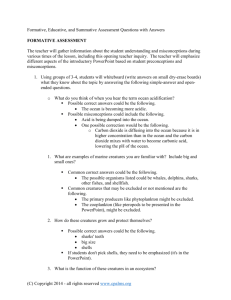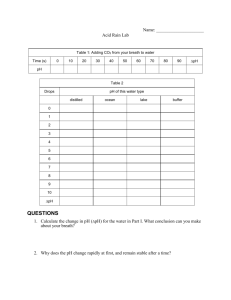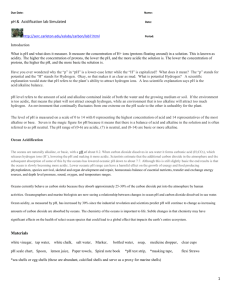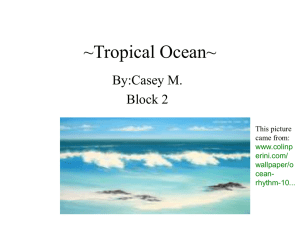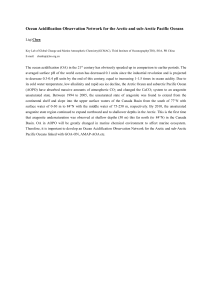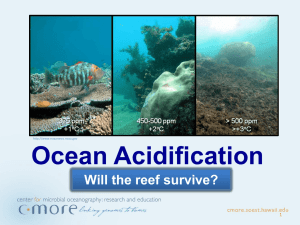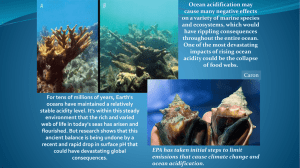example lab report
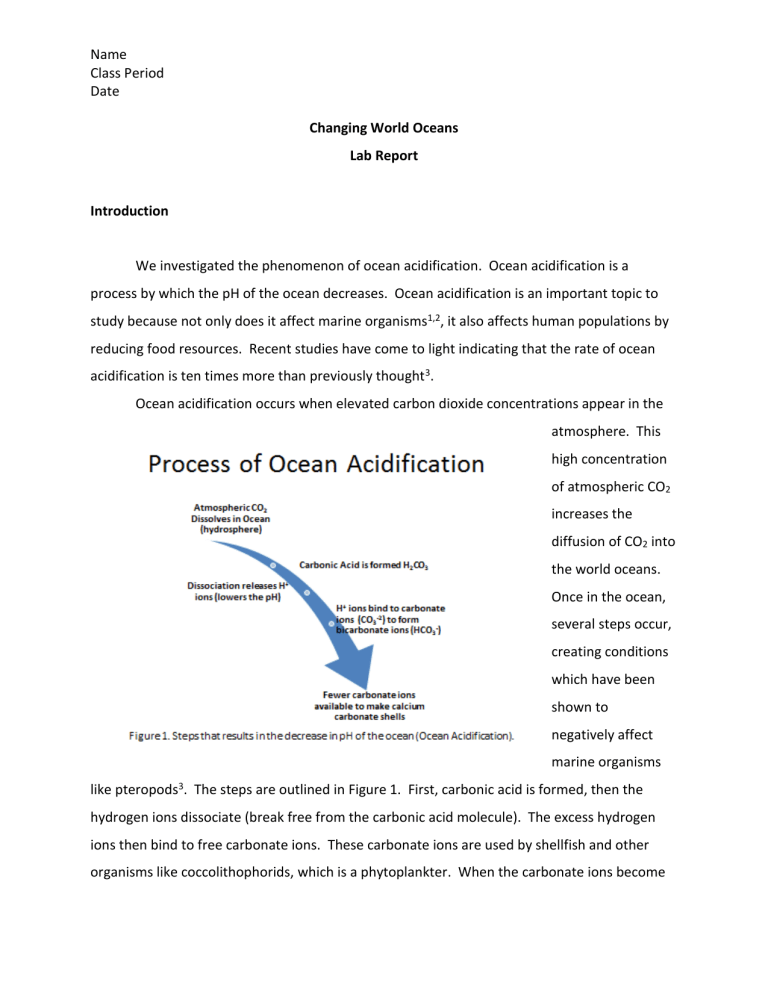
Name
Class Period
Date
Changing World Oceans
Lab Report
Introduction
We investigated the phenomenon of ocean acidification. Ocean acidification is a process by which the pH of the ocean decreases. Ocean acidification is an important topic to study because not only does it affect marine organisms 1,2 , it also affects human populations by reducing food resources. Recent studies have come to light indicating that the rate of ocean acidification is ten times more than previously thought 3 .
Ocean acidification occurs when elevated carbon dioxide concentrations appear in the atmosphere. This high concentration of atmospheric CO
2 increases the diffusion of CO
2
into the world oceans.
Once in the ocean, several steps occur, creating conditions which have been shown to negatively affect marine organisms like pteropods 3 . The steps are outlined in Figure 1. First, carbonic acid is formed, then the hydrogen ions dissociate (break free from the carbonic acid molecule). The excess hydrogen ions then bind to free carbonate ions. These carbonate ions are used by shellfish and other organisms like coccolithophorids, which is a phytoplankter. When the carbonate ions become
Name
Class Period
Date scarce, the organisms may not be able to effectively build their shells, rendering them adapted to their environment.
In the first part of our experiment we modeled the interaction of the atmosphere (with an increased concentration of CO
2
) and the hydrosphere into where the CO
2
dissolved. We monitored pH changes in buffered and unbuffered water samples. In the second part we tested the effect of acid on sea shells, using vinegar, and in the third part we tested the effect of acid on proteins using qualitative comparisons by placing fish muscle tissue in lemon juice.
Our hypotheses for these experimental parts were as follows in Table 1.
Table 1. The statistical hypotheses we tested for the 3 parts of the lab activity.
1 If the carbon dioxide content increases in the air then it will diffuse into the water
2 If acids are added to buffered and unbuffered solutions then the solution with the buffer will change (decrease) a smaller amount than the unbuffered solution.
3 If the shells are affected by acidic environments then the shells will lose mass when placed in acid
4 If proteins are affected by acidic environments then fish filets placed in acid will change their appearance
Materials and Methods
We used the following materials for the 3 parts of the lab in Table 2.
Table 2. The materials used in the ocean acidification lab activities.
Vinegar Baking soda Scoopula
1-L container Fish tank air hose tubing
Clear plastic bin or 5L fish tank pH strips or pH probes (2)
Duct tape
CO
2
probe
Masking tape / marker 15cm (6in) pie tins (4) Deionized water (1L)
Deionized water wash bottle 500ml beaker (waste water) Graduated cylinder
Balance Waxed paper Forceps
Sea shells (various sizes) (3) Raw fish filet (1X2X1 cm)
Paper towels Styrofoam cups
Lemon juice
We constructed a tank modeling the atmosphere / hydrosphere interface as shown in Figures 2 and 3. We mixed baking soda and vinegar to create a source of carbon dioxide and fed the gas into the tank using the aquarium tubing. The pie tins and pH probes were secured using tape and cut styrofoam cups. The carbon dioxide probe rested on the lab table. A data recorder was connected to the probe sensors. Baking soda and vinegar were added periodically to maintain
Name
Class Period
Date a high concentration of carbon dioxide in the enclosed area. Duct tape was used to seal the gap between the tank and the table created by the tubes going into the tank.
Carbon dioxide concentration and pH data were collected continuously for 30 minutes. During the waiting period, sea shells were massed and put into vinegar. Observations were made and then the samples soaked overnight. Ending mass was recorded the next day. A
1x2x1 cm block of fish filet was cut, qualitative observations were made and the fish massed then placed in another pie tin. Lemon juice was added to completely submerge the fish and the sample was set aside for overnight soaking. Ending observations were made the next day.
Graphs were constructed from pooled classroom data in an Excel spreadsheet and before and after mean mass statistical comparisons made using t-tests which the teacher performed. Pooling the data allowed for multiple measurements and statistical testing.
Results
Part 1: Atmosphere / hydrosphere interactions
The experimental setup successfully raised the CO
2
concentration in the tank from 250 to 8417 ppm with the last 10 minutes ranging from 4000 to 6000ppm (Figure 4). The pulsed increases in CO
2
were a result of adding more baking soda and vinegar to the 1L bottle.
Name
Class Period
Date
The pH of the buffered and unbuffered water samples showed different responses to the high atmospheric carbon dioxide. The pH from the unbuffered water sample dropped from
7.9 to 7.4 while the pH from the buffered solution stayed relatively steady maintaining a pH of
8.2 throughout most of the trial period (Figure 5).
In using classroom data and comparing the beginning and ending pH readings of buffered and unbuffered water, there was a difference in the two water samples. Paired ttests revealed a significant change for the buffered water (t(4) = 18.99, p <
.001), however there was no significant change for the unbuffered water
( t(4)=1.00,p=0.37) (Table 3).
When shells were exposed to an acidic environment they lost mass (Table 4).
The acid of the lemon juice changed the consistency of the raw fish. Initially the fish was flexible and translucent. After soaking the fish overnight in the acid it became more firm and opaque.
Name
Class Period
Date
Table 3. Comparison of the change in pH of buffered and unbuffered conditions.
Group Unbuffered Buffered
4
5
6
1
2
3
Average
SD
95% Confidence
Beg.
7.9
7.8
7.7
7.9
7.7
7.6
7.77
End
7.4
7.5
7.3
7.5
7.3
7.2
Diff.
-0.5
-0.3
-0.4
-0.4
-0.4
-0.4
7.37 -0.40
0.06
0.05
Beg.
8.2
8.1
8.3
8.2
8.1
8.2
8.18
End
8.2
8.2
8.2
8.1
8.0
8.2
Diff.
0.0
0.1
-0.1
-0.1
-0.1
0.0
8.15 -0.03
0.08
0.07
Name
Class Period
Date
Discussion
We set out to investigate the carbon dioxide interactions between the atmosphere and hydrosphere and to see the chemical and biological effects of such interactions. We successfully created a high concentration of carbon dioxide in our model atmosphere. This high concentration of CO
2
diffused into the water samples and decreased the pH of the unbuffered water sample, which mimicked the process of ocean acidification and supported our first hypothesis. Our second hypothesis was also supported. The buffered water sample showed no change in pH, indicating the importance of having buffers in a solution to protect from pH changes. This is in contrast to the unbuffered water sample which significantly decreased in pH. Our third hypothesis was also supported by the data. Even though we used a variety of shell species, they all lost mass to a greater or lesser extent when exposed to acidic conditions.
Finally for our fourth hypothesis we provided supporting evidence of a qualitative change in the protein of the fish filet.
Although we attempted to have strict controls of our experiment, we did have some conditions that may have added to the variability of our data. We did not always put in the same amount of vinegar and baking soda in the feeder bottle (some spilled) and that may be why we had such a big spike in the carbon dioxide in the atmosphere at the 15 minute mark of our sampling.
Our setup was meant to model what is happening in the real world, but some important differences need to be mentioned. In nature the highest natural carbon dioxide concentrations are in the 300-400ppm range, we created concentrations much higher than that to ensure we could see results in a short amount of time. The same could be said for the shells in the vinegar. The pH of vinegar is ~3 whereas the ocean pH is ~8.0. This exaggerated increase in acidity allowed us to see the effects on a short time scale. Similarly, the lemon juice pH is 3 and the effect on proteins was also exaggerated because of the higher ocean pH. This process of putting fish in lemon juice is known as making ceviche, a Hispanic dish where the fish are
“cooked” in acid instead of cooking with heat. Both processes do the same thing by denaturing
(changing the shape) of the proteins.
Our experimental setup allowed us to see the physical, chemical, and biological effects of ocean acidification. The acidification of the oceans has already affected marine organisms like pteropods, which are vital to the food web of the eastern Pacific Ocean where they live.
These marine pelagic mollusk shells get degraded from the low pH conditions found there.
Other studies have shown that conchs cannot escape predators because of neurotransmitter deficiencies due to conditions of high carbon dioxide 2 . If similar afflictions affect organisms lower in the food web, it could severely change the ecosystem stability because each of the organisms in the next trophic level would also be affected.
This study is inspiration for further studies. We could investigate the effects of different water temperatures and how the uptake of carbon dioxide in the water changes with different water temperatures. We could also test different shell species and different proteins like fish slime so see how that reacts to changing pH.
Name
Class Period
Date
We could improve our experiment by adding a control to the shell experiment, using deionized water to compare loss of mass of shells. We should test all the same species of shell and determine the type of crystal structure it has (calcite, high magnesium calcite, or aragonite) to further refine our knowledge of which organisms would most be affected by ocean acidification.
To conclude, we learned that ocean acidification is a process we must educate ourselves on and work on ways to reduce this process. The only way we see this changing is if we reduce the concentrations of carbon dioxide in the atmosphere. In order to reduce carbon dioxide in the atmosphere, we need to burn fewer fossil fuels. We need to assess our own lifestyles to see how we can be more energy efficient in all that we do. We can start with simple things like turning off lights, use energy efficient cars, closing the door when we go outside to conserve air conditioning, and many other little things. We need to be good stewards of our planet to ensure we have a good quality of life.
Name
Class Period
Date
Literature Cited
National Oceanic and Atmospheric Administration. (2014, April 30). Ocean acidity is dissolving shells of tiny snails off U.S. West Coast. ScienceDaily. Retrieved June 26, 2014 from www.sciencedaily.com/releases/2014/04/140430101914.htm
Society for Experimental Biology. (2013, July 5). Jumping snails leap over global warming.
ScienceDaily. Retrieved June 26, 2014 from www.sciencedaily.com/releases/2013/07/130705101824.htm
The Earth Institute at Columbia University. (2014, June 2). Modern ocean acidification is outpacing ancient upheaval: Rate may be ten times faster. ScienceDaily. Retrieved June
26, 2014 from www.sciencedaily.com/releases/2014/06/140602170341.htm
